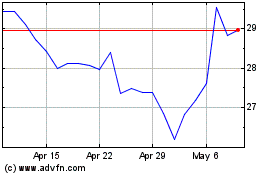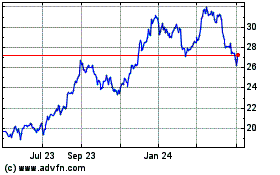The Securities and Exchange Commission is preparing a civil
enforcement case against Merrill Lynch over an investment that fell
as much as 95% in value and was marketed in a way that one of the
firm's financial advisers called "borderline crooked," people close
to the probe said.
The expected case against the brokerage arm of Bank of America
Corp. underscores some of the risks of so-called structured notes,
securities custom-built by banks out of options and other
derivatives and often sold to retail investors.
It also brings to light a dispute between Merrill and two of its
brokers who sold structured notes to their clients. With clients
complaining after the value of the notes plunged, the brokers
secretly taped calls with executives at Merrill, left the firm for
rival UBS Group AG and then filed a whistleblower complaint over
the notes with the SEC.
The probe involves a product called Strategic Return Notes that
Merrill sold over a number of months in 2010, raising about $150
million. Linked to a Merrill Lynch index tracking the volatility of
the S&P 500 stock index, the five-year notes lost value rapidly
after they were issued, as market volatility fell and the cost of
buying the options upon which the notes were based rose
sharply.
Those so-called roll costs averaged about 12% of the principal
per quarter in the first half of 2011, before falling to an average
of less than 4% per quarter in the second half of the year,
according to Merrill. In the calls, the brokers allege they were
never told the costs could grow so large.
"The roll costs are far larger than we ever understood or were
disclosed to us," Merrill broker Glen Ringwall said, according to
the transcripts of the calls he taped with colleague Mark Manion.
"This is borderline crooked."
Brian Partridge, head of U.S. product sales for Merrill's
wealth-management division at the time, who wasn't aware the call
was being taped, pushed back. He acknowledged the costs were higher
than expected, but said that was due to market conditions and that
the product, designed as a hedge, performed as intended, according
to the transcripts. The problem, he said, was that the investors
were on the wrong side of the market.
"It is not a rigged game," he said in the transcripts, adding
that volatility had performed in the worst possible way for the
product. "We've been, quite frankly, snake bitten."
The advisers were told on the calls not to suggest to their
clients the product was flawed.
"What you'd love to do is avoid customer complaint," Mark Ryan,
a manager at the firm, told Messrs. Ringwall and Manion. "We can't
just tell everyone, 'Hey this is a defective product.'"
Merrill spokesman William Halldin declined to comment on behalf
of Messrs. Partridge and Ryan, who couldn't be reached
directly.
The advisers recorded the calls in August 2011, when they were
facing potential complaints from investors in the notes, which had
lost more than half their value. The two brokers moved to UBS in
July 2012 and submitted a whistleblower complaint to the SEC the
following September alleging defects in the Merrill notes,
according to their lawyer Rebecca Katz. The advisers can claim a
reward if their tip leads the SEC to bring a case against Merrill
and impose sanctions of more than $1 million.
Mr. Halldin, the Merrill spokesman, said the notes were designed
to be part of a larger portfolio and that the risks and costs were
fully disclosed to advisers and investors.
He pointed to an email sent by Mr. Ringwall to a Merrill
official in July 2011 thanking managers for a conference call that
had discussed the high roll costs. "VERY helpful explanation and
rational," Mr. Ringwall wrote, according to a copy reviewed by the
Journal.
Ms. Katz, the lawyer representing Messrs. Ringwall and Manion,
said the two men hoped Merrill would help their clients and acted
after it became clear the bank wouldn't.
An SEC spokesman declined to comment.
The $10 notes that matured in November had a redemption value
from Merrill of 50 cents, according to data provider FactSet. The
bank said most investors sold the notes in the first year.
Banks sell $40 billion to $50 billion of structured notes each
year. They rank among the most common types of securities in
arbitration claims filed with the Financial Industry Regulatory
Authority. Amy Starr, an SEC official, said in a speech last year
that she wonders "how many brokers and advisers who sell these
products to retail investors actually understand what they are
selling."
Andrew Stoltmann, the Chicago-based lawyer representing
investors who have filed Finra claims against Merrill, said firms
"have a massive financial incentive to create these complex,
conflict-laden and untested structured investments."
The recorded phone calls are cited in arbitration claims filed
against Merrill in March and April on behalf of 44 investors who
lost a total of $1.2 million.
One of those investors, Till Bruett, a 78-year-old retired
banker from Panama City Beach, Fla., said he bought $109,545 of the
notes. In an interview, he said he was told the product would
protect his investments in a volatile market. But in the summer of
2011, as the market was falling, "I got a call from my investment
adviser who said, 'Till, this product is not working at all. In
fact it's doing exactly the opposite, and we need to sell it.'"
Mr. Bruett sold the notes for $72,192, incurring a loss of
$37,353, according to the arbitration claim. "I feel totally misled
by the information that Merrill sent me," he said.
The investors say in the claims that they aren't complaining
about the conduct of Messrs. Ringwall and Manion, who sold them the
notes.
A handful of claims filed by other investors against Merrill and
the two advisers in relation to the notes have already been
settled, according to a regulatory database. In comments in the
records, the brokers each denied any wrongdoing or liability.
Write to Jean Eaglesham at jean.eaglesham@wsj.com
(END) Dow Jones Newswires
June 21, 2016 17:55 ET (21:55 GMT)
Copyright (c) 2016 Dow Jones & Company, Inc.
UBS (NYSE:UBS)
Historical Stock Chart
From Mar 2024 to Apr 2024

UBS (NYSE:UBS)
Historical Stock Chart
From Apr 2023 to Apr 2024
